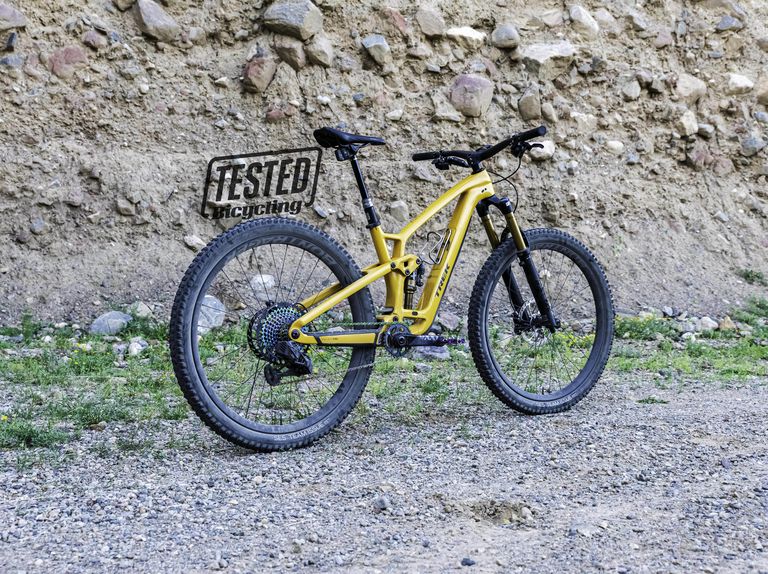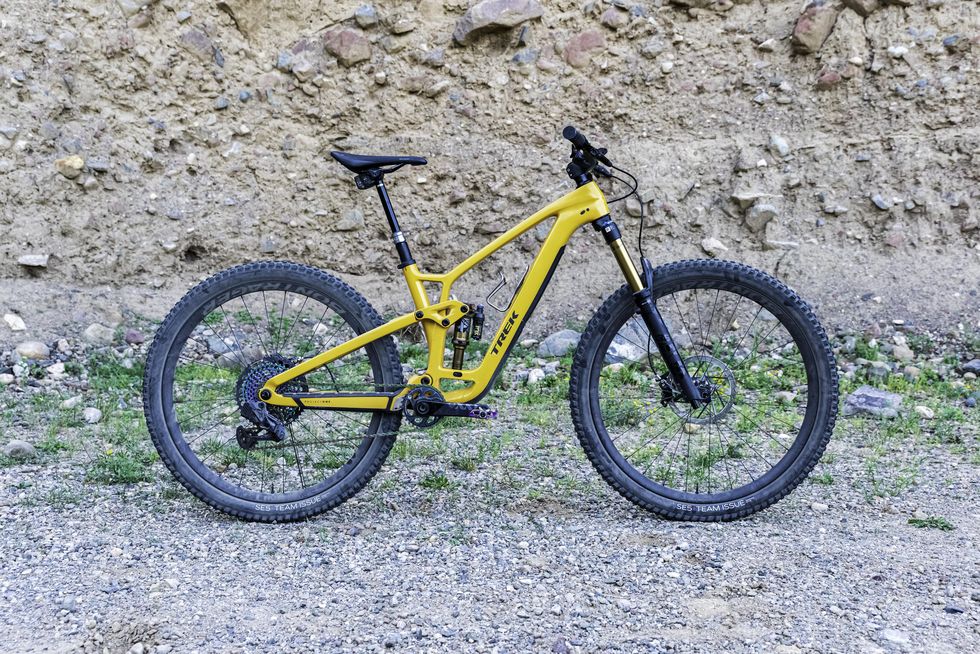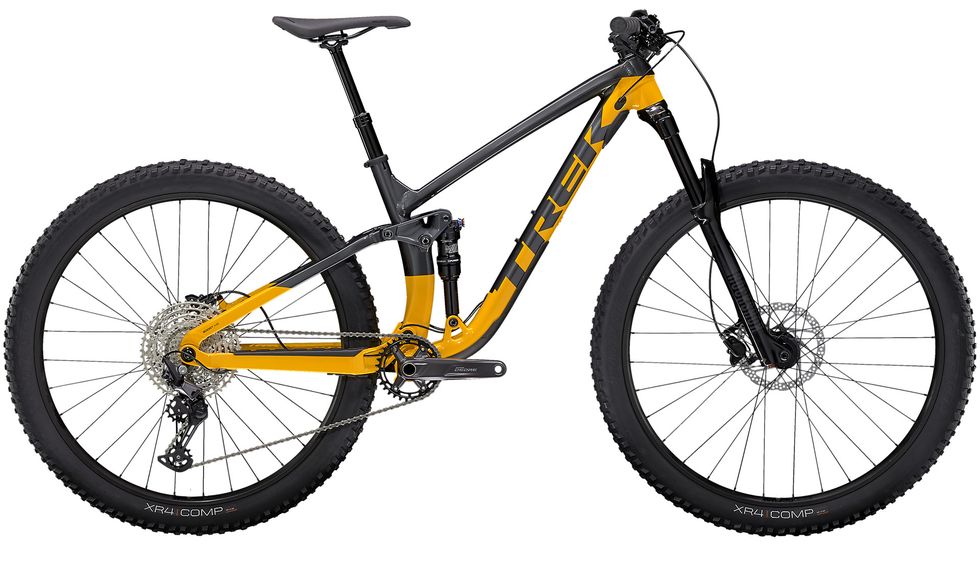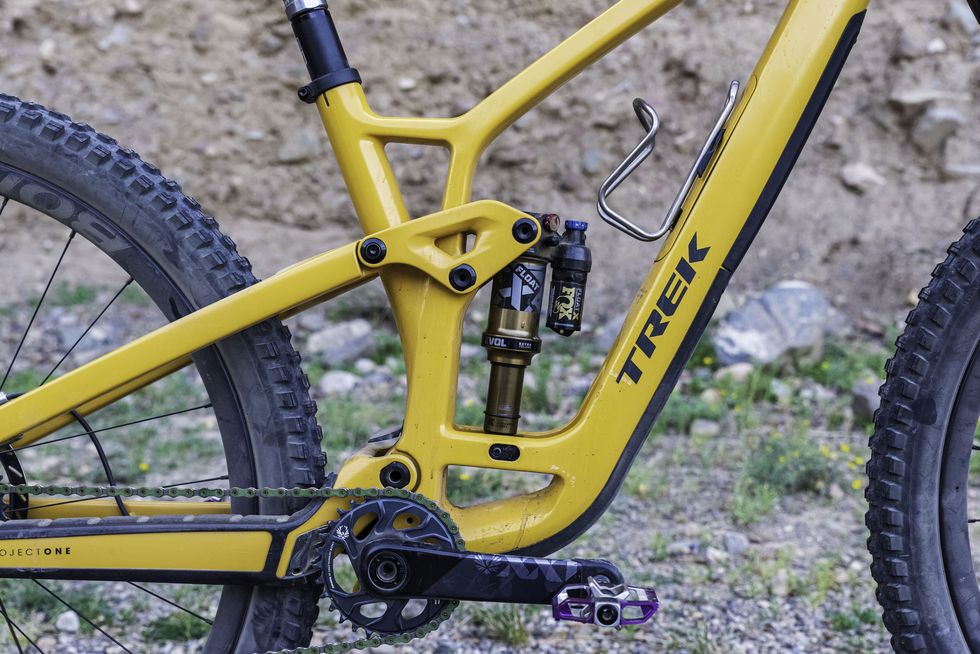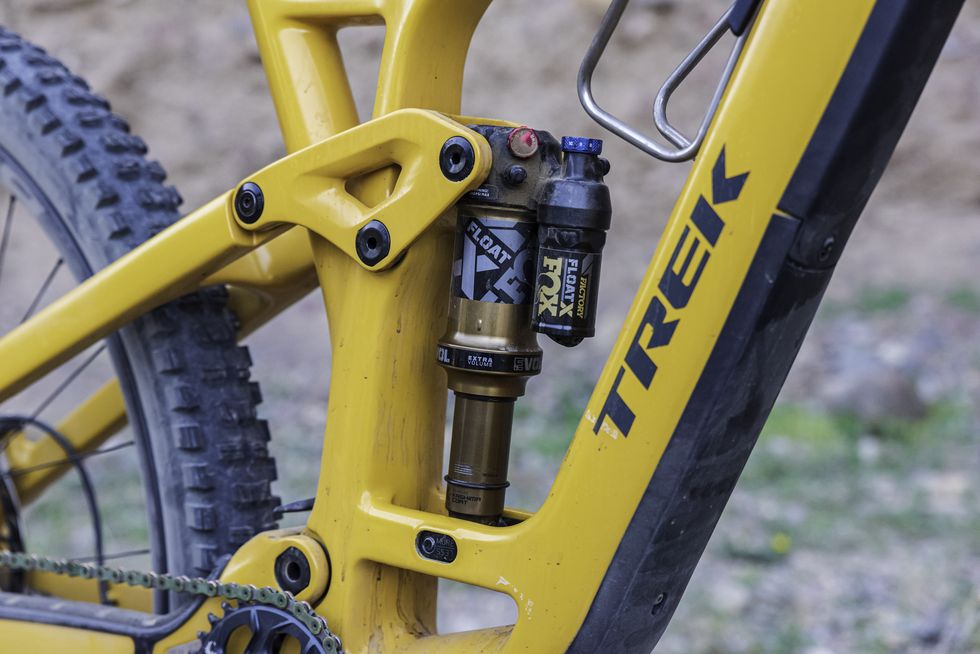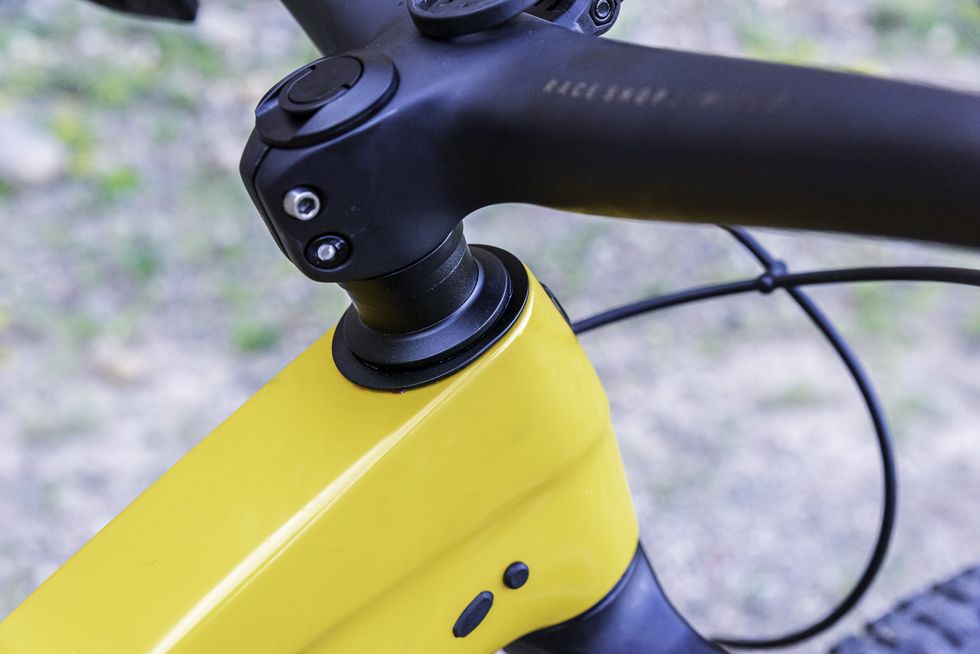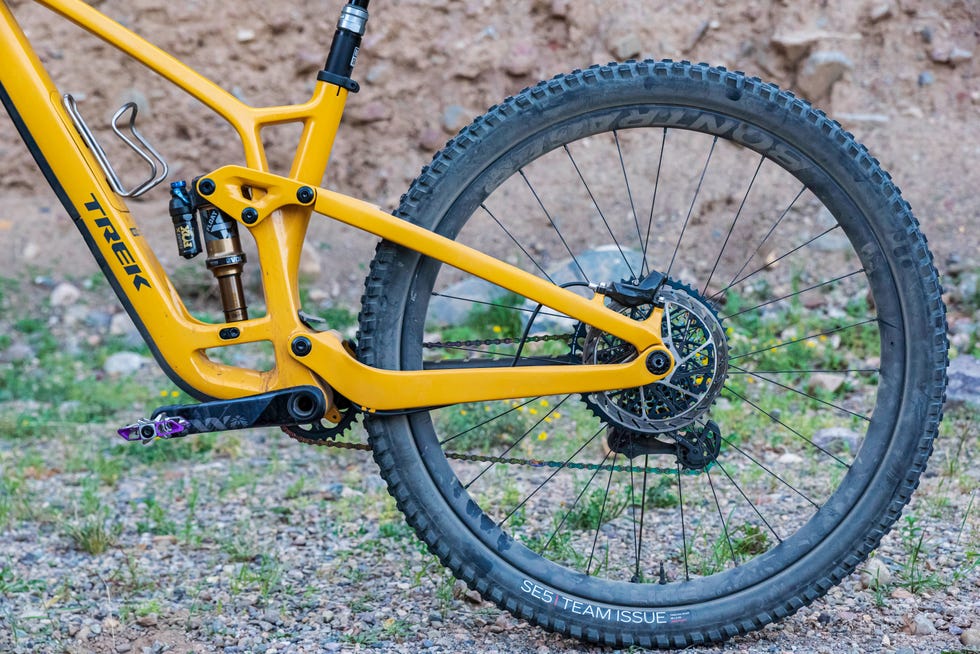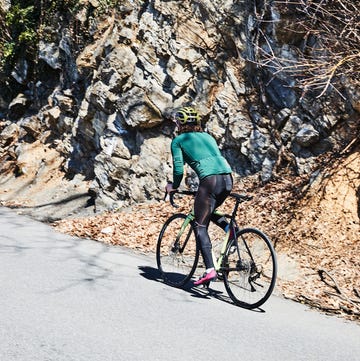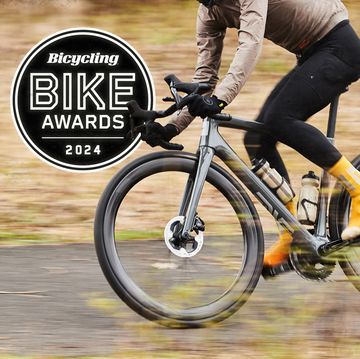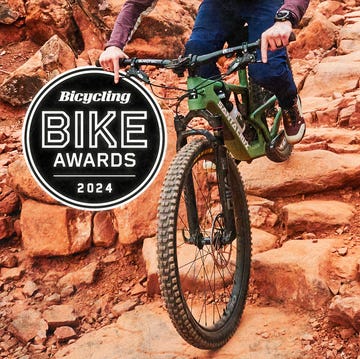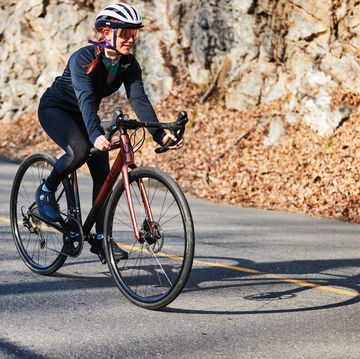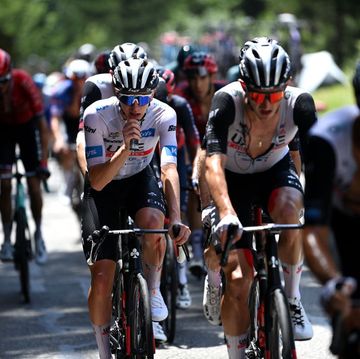The Takeaway: The new EX is bigger and more capable. It faces tougher competition, but its performance, features, and adaptability make it a compelling option.
- 10mm more travel: now 140mm rear and a 150mm fork
- Two different geometry adjustments, plus adjustable shock rate
- Most aluminum frames now get internal storage
- Eight builds with the new platform starting at $3,700
Price: $2,700 to $10,750. As tested $10,750 (EX 9.9 XX1 AXS)
Weight: 30.2 lb. to 35.2 lb. (claimed. 31.2 lb. as tested (EX 9.9 XX1 AXS, size medium)
I knew this bike was coming from the moment Trek debuted the Fuel EX-e electric bike in July with a frame that looked nothing like Trek’s other bikes. I even called it. Self-congratulations aside, this is the new Fuel EX; the full suspension trail bike at the heart of Trek’s mountain bike line.
Trek tries to cover a lot of ground with this one bike, which is why it has so many features and adjustments, plus a wide range of models and sizes. By trying to do so much with one bike, I worried that in making a bike to satisfy everyone, Trek made a bike that satisfies no one. After riding it I don’t think that’s the case. It’s no Holy Grail, but it is a fine machine for many riders, and a variety of terrain.
Trek Fuel EX—Builds, Prices, and Weights
The new Fuel EX launches with eight stock builds (three aluminum models and five carbon). The least expensive model, Fuel EX 5, uses the old frame platform (130mm rear travel with 140mm fork), while the rest use the new 140/150mm platform. Prices start at $2,700 for the EX 5 and top out at $10,750 for the EX 9.9 XX1 AXS.
Claimed frame weights are 3.4kg (7.5 lb.) for the carbon frame and 4.6kg (10.1lb.) for the aluminum frame. Complete bike weights start at 13.71kg (30.2lb) for the 9.9 XTR and go up to 15.96kg (35.2lb).
If you’re not feeling the stock options, the Fuel EX will drop into Trek’s Project One customization program (eventually) if you want to pick your paint and parts.
Trek Fuel EX – What’s New
Comparing the previous generation Fuel EX to this one, it is obvious this bike isn’t a mid-cycle refresh but a ground-up redesign of the brand’s mid-travel trail bike.
Outwardly, the Fuel EX displays a new frame design direction for Trek. First seen on the sibling EX-e electric bike, the new frame is more swole, with additional trusses linking the top tube to the seat tube and the seat tube to the down tube.
Part of the reason for the stouter-looking frame is a 10mm bump in travel at both ends: The rear increases to 140mm, paired with a 150mm fork. An additional change to the suspension is a two-position leverage-rate flip chip which offers a more and a less progressive setting. This is much easier than swapping volume spacers inside an air shock and also (in the more progressive position) makes the EX compatible with coil-spring shocks for the first time. But note that changing the leverage rate on the shock affects the spring and damper while changing volume spacers affects only the spring.
Trek also approved most of the new EX frames for the stouter RockShox Zeb and Fox 38 forks in up to 160mm travel.
With the bump in travel, the EX features revised geometry. The TL;DR: A 10 to 20mm longer reach, 1.5-degree slacker head tube angle, about a two-degree steeper seat tube angle, and size-specific chainstay lengths. As before, the EX has Trek’s two-position Mino Link in the rocker (which alters head and seat angles and BB drop.) New to the party are angle-adjusting headset cups which offer three head angle possibilities with no effect on bottom bracket drop/height. And if you like your wheel sizes mixed, the new EX is rated for that too.
The seat tube sees revisions that help it fit longer-travel dropper posts, and the post diameter was bumped up to 34.9mm. Your mileage may vary, but I’ve found the 34.9mm droppers operate more smoothly and are less likely to bind than 31.6 or 30.9mm droppers.
Trek added full-length guides to the EX’s internal routing to make assembly and maintenance easier, plus they can’t slap around in the downtube anymore. The guides also mean the hoses and hosing don’t interfere when you’re stuffing the repair kit burrito into the EX’s downtube. And talking of that downtube storage, it’s now built into the aluminum frames, in addition to the carbon.
The bottom bracket shell is now threaded, and there is a whole mess of plastic bolted to the downtube for impact and shuttle protection. Features carried over from the previous generation include Trek’s ABP suspension system, ISCG ’05 tabs, and the Mino Link flip chip in the rocker link.
Trek Fuel EX—No More Proprietary Shocks
One of the less conspicuous (but very significant) changes to the new EX is the adoption of a stock shock. Gone is the Thru Shaft design—which required a screw-in lower extender for the shock shaft—and the regressive Re:Activ damper tune. In its place is a standard shock, although it is custom-tuned for the frame (a step that all reputable brands take).
Abandoning suspension features has been somewhat of a theme for the Fuel EX. Follow the progression of EX since its debut in 2005, and you will see Trek adding new rear suspension technologies only to remove them for later iterations. This includes Full Floater (dynamic upper and lower shock mounts), DRCV (dual rate control valve) shocks (some EX forks had DRCV also), RE:Activ, and Thru Shaft. If you add in other since-abandoned features like Knock Block (a stop which limited handlebar rotation), and Press Fit 92 bottom brackets, previous generation EXs are a boneyard of forsaken technologies.
Why are Thru Shaft and Re:Aktiv gone? I asked Trek that question and am yet to receive a response. I sense that Trek will say the same thing they said when I asked why they eliminated Full Floater from the 2020 Fuel EX: That the newest generation of shocks (like Fox‘s Float X) make those proprietary technologies redundant.
The benefit to the rider is the new Fuel EX uses a standard trunnion mounted shock, which means they can choose to ride a wide variety of options. Trek says they’ve confirmed fitment of all Fox, RockShox, and DVO air and coil shocks. Plus, it fits the Push ElevenSix and EXT’s Storia coil.
Trek Fuel EX—Updated Geometry, More Adjustments, Mullet Compatible
As previously mentioned, the Fuel EX receives all-new geometry. And it gets expanded geometry adjustment options. There are now two geometry adjustments: Head tube angle cups (three options: zero, plus-one degree, minus-one degree), and Mino Link (two positions: alters head and seat angles +/- 0.5 degrees and bb height +/- 8mm). That results in six configurations in total.
There are seven frame sizes (extra small, small, medium, medium/large, large, extra-large, and double-extra-large) in aluminum and six in carbon (no double-extra-large). And the EX now has size-specific chain stay lengths and seat tube angles. And the extra small and small come with 27.5-inch wheels, while the rest come with 29-inch wheels (size small is available with either 29" or 27.5" wheels.) AND Trek made the EX (with 29" wheels) compatible with mixed wheel sizes, but when running a 27.5 rear wheel, Trek recommends 160mm fork travel (10mm more than stock) and putting the Mino Link in high mode.
Is it any wonder that Trek has a dynamic geometry tool on its website to help you parse all the different configurations?
All this makes comparing the geometry to the previous EX difficult, but to get a flavor of the changes, I’ll compare the old size large to a new size large. With both in “stock” geometry configuration (Mino Link in low for both, the new frame with the neutral headset cup), the new bike measures up as follows:
Reach - 15mm longer (485 vs. 470mm)
Stack - about eight millimeters taller (621.3 vs. 613mm)
Effective seat angle - 2.5 degrees steeper (77.2 vs. 75 degrees)
Head angle - 1.5 degrees slacker (64.5 vs. 66 degrees)
Trail - almost 10mm longer (129.3 vs. 119mm)
Chainstays - three millimeters longer (440 vs. 437mm)
Wheelbase - almost 40 millimeters longer (1250.2 vs. 1211mm)
I’m not going to bother pasting the nine different geometry charts Trek sent me into this story (because that would be ridiculous.) The stock head angle is 64.5 degrees: If you want to nerd out on the rest of the numbers, dial-up Trek’s geometry tool and dig in.
Trek Fuel EX—Ride Review
The biggest mistake I made during my first rides on the new EX was comparing it to the outgoing 130/140mm EX. I loved the previous generation, and I liked its somewhat unique positioning between 120mm trail bikes like Evil’s Following and bigger trail bikes like the Pivot Switchblade.
But the new EX is not the old EX: It’s a bigger and more capable bike. It can be ridden harder and in rowdier terrain. But because it is heavier, longer, slacker, and has more travel, the new bike doesn’t feel as snappy as the outgoing bike. And it doesn’t feel as crisp on the climbs either. If you’re looking for a trail bike more like the old EX, the closest you’ll get in Trek’s current line is a Top Fuel with a 130mm fork upgrade.
Once I got my head straight about what the EX was all about, I began to groove with it. The Fuel EX is an excellent trail bike. Well, I have one complaint. I was getting some noise from the front end. I solved this by pulling the entire headset assembly, cleaning, greasing, and reinstalling it—chuckling to myself the whole time because Trek’s product team said they designed the system the way they did because they found competitors' adjustable head angle systems were noisy.
With six possible geometry settings—nine if I fitted a 27.5 rear wheel, which I, so far, have not—there wasn’t time to evaluate them all adequately before today’s launch. So, I’ve done all my rides on the EX in the stock setting (Mino Link in low, headset in the neutral position). And in that setting, the EX is a well-rounded trail bike.
I did my first ride on the EX in Whistler, British Columbia where I ground up the steep climbs and then pointed down tight, rough, and frequently very steep and technical trails that dot the landscape. The EX held its own, offering a comfortable climbing position and an efficient and supportive pedaling platform on the climbs. On the descents, it was reassuring; equal parts precise and confidence-inspiring. I decided to run the shock rate in the progressive position for this ride and was happy I did as the rear end returned suppleness with plenty of support and bottom-out resistance.
I expect some riders will find the EX, even with its new and more muscular body, is not quite enough bike for Whistler-style riding, which I can understand. But it can hold its own while the old EX would be out of its element.
I got the rest of my rides on the new EX in Durango, Colorado. Compared to B.C. riding, the climbs in Durango typically aren’t as steep, and the descents are faster, more open, and not as consistently technical, but the altitude is much higher. The EX felt a bit more in its sweet spot here, and I used the less progressive shock rate, which gave me a deeper-feeling suspension. With the lightest EX coming in at over 30 pounds, I’m not going to say I’m thrilled to hammer out a multi-hour singletrack climb at five-figure altitudes on this bike. It is efficient and accurate enough on climbs that I will ride it up because the payoff on the descents is so worthwhile.
I can’t say that I found any one thing, or things, in my testing of the EX so far that rocked my world. It seems to do everything it is supposed to do well. It’s appropriately stiff and feels solid, the suspension works well over a wide range of situations, and the pedaling and braking performance is good also. Performance-wise, it seems to be in the same ballpark as the other good trail bikes of similar travel I’ve ridden.
But I think this EX will be a slow burn. A bike I enjoy more and more as I spend additional time on it. I have no science to back that feeling up, just a gut sensation based on years and years of testing bikes. I have experienced other bikes sneak up on me and become a favorite after being lukewarm about them at first. And I do love how much Trek built into this bike: There’s a ton going on with it when you dig into the details, and much of it will help riders dial in the bike better for their conditions and preferences. In the long run, this should make the new EX easier with which to live.
Sometimes it’s the quiet ones that are the most special.

A gear editor for his entire career, Matt’s journey to becoming a leading cycling tech journalist started in 1995, and he’s been at it ever since; likely riding more cycling equipment than anyone on the planet along the way. Previous to his time with Bicycling, Matt worked in bike shops as a service manager, mechanic, and sales person. Based in Durango, Colorado, he enjoys riding and testing any and all kinds of bikes, so you’re just as likely to see him on a road bike dressed in Lycra at a Tuesday night worlds ride as you are to find him dressed in a full face helmet and pads riding a bike park on an enduro bike. He doesn’t race often, but he’s game for anything; having entered road races, criteriums, trials competitions, dual slalom, downhill races, enduros, stage races, short track, time trials, and gran fondos. Next up on his to-do list: a multi day bikepacking trip, and an e-bike race.
